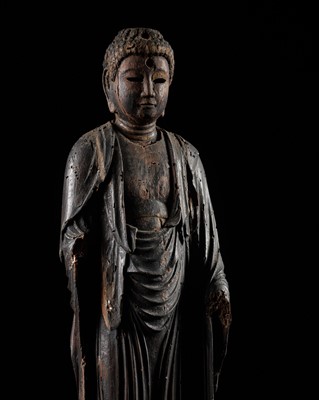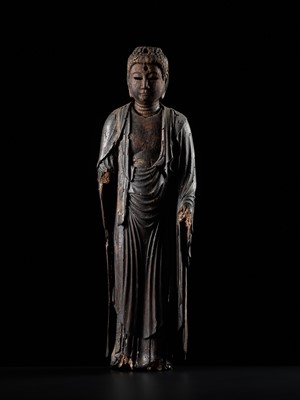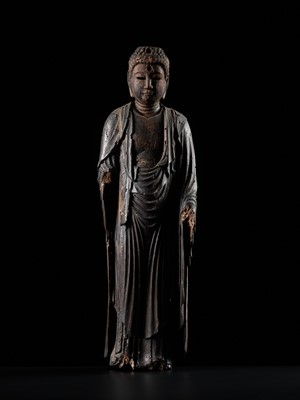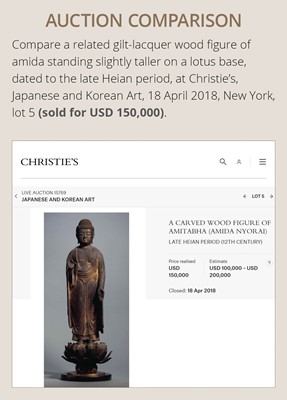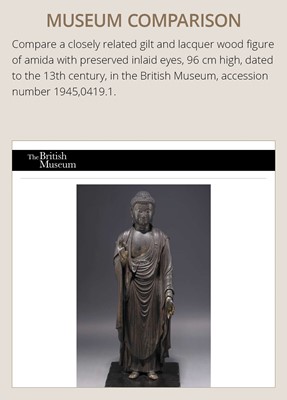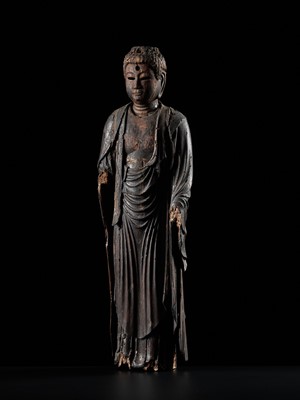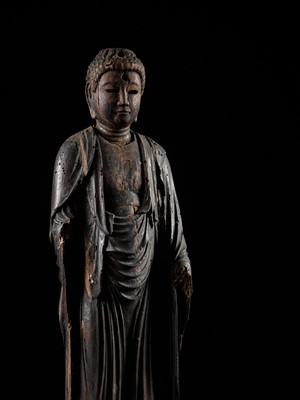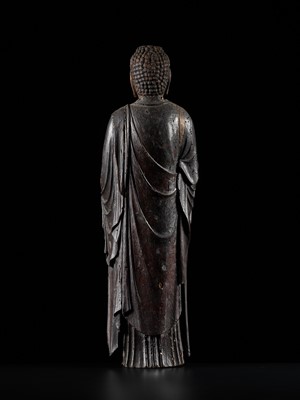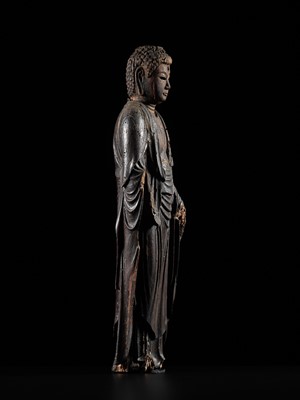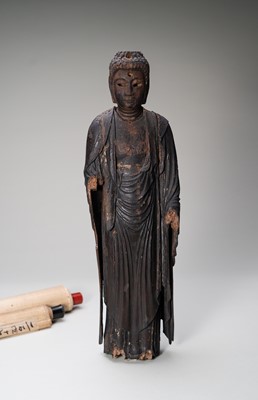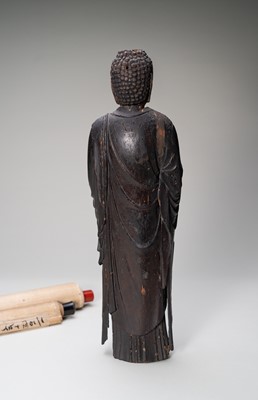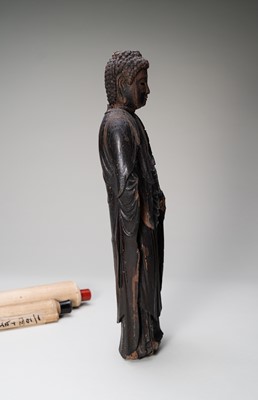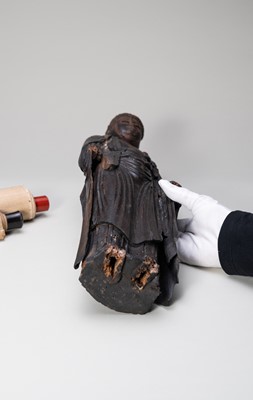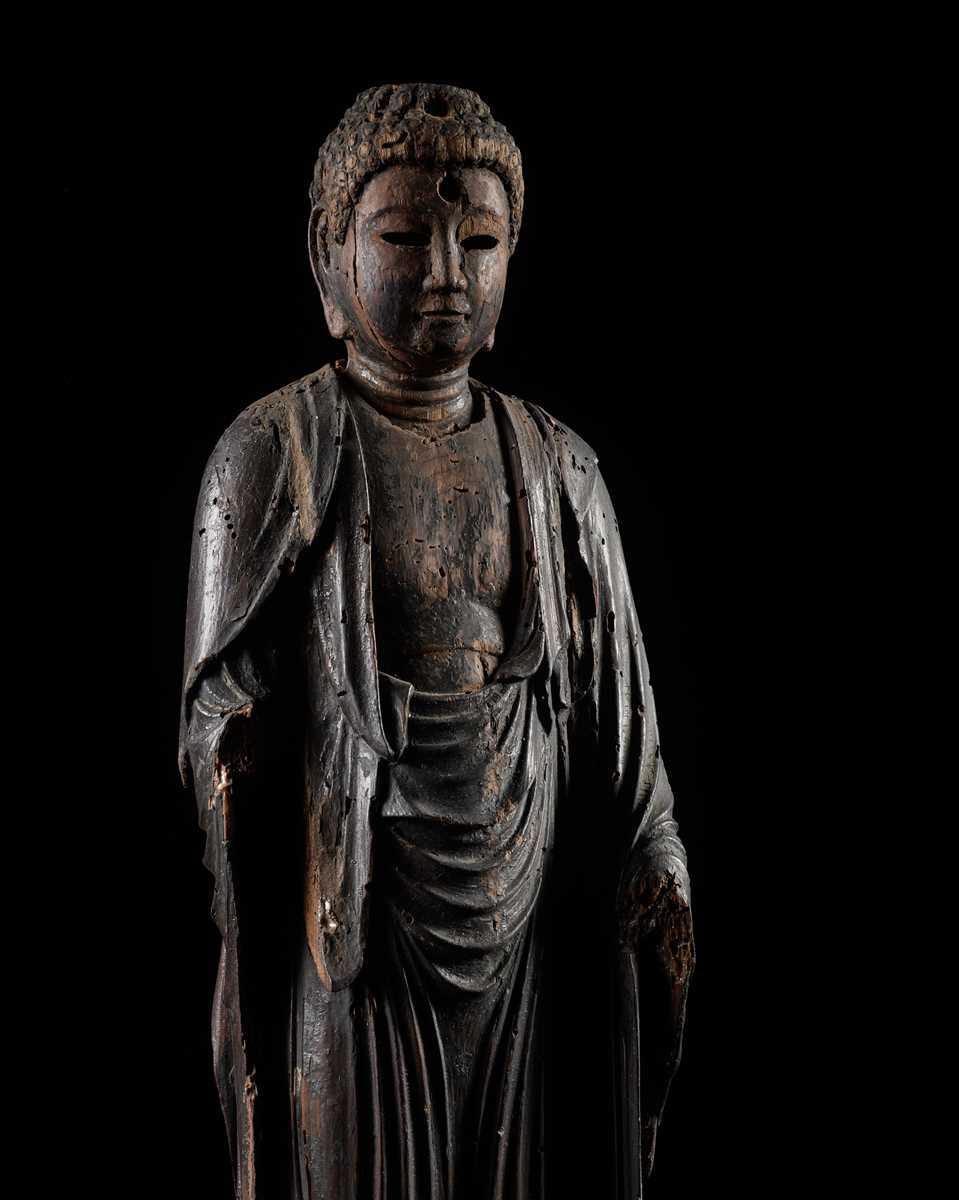17th Jan, 2024 11:00
Asian Art Discoveries
52
A CYPRESS WOOD FIGURE OF AMIDA NYORAI, HEIAN TO EARLY KAMAKURA
Sold for €2,600
including Buyer's Premium
Japan, 11th-12th century, late Heian (794-1185) to early Kamakura period (1185-1333)
Finely carved from a hollowed section of hinoki (cypress) wood in yosegi-zukuri with traces of lacquer and gilding in a classic Heian standing pose with his right arm raised and left arm lowered in what was likely raigo-in (vitarka mudra). Amida is wearing monastic robes, his fukuken'e descending from the shoulders and forming a series of folds over the abdomen, the kun with typical Y-shaped and vertical pleats. The soft features of his face bearing a serene expression, subtly smiling lips, elongated lobes, and hair arranged in spiral curls; his eyes were once decorated with inlays and now open to the hollow interior giving the piece a striking presence combined with the well-worn nature of the wood.
HEIGHT 51.5 cm
Condition: Extensive wear commensurate with age, the wood with natural imperfections including signs of insect activity, expected age cracks, losses, remnants of old repairs and resin residue, the hands and feet lost.
Provenance: From a French private collection.
The present figure has characteristics of both Heian and early Kamakura sculptures. Yosegi-zukuri was a technique adopted in Japan from Indian and Chinese artists and became popular during the 10th century. The elegant folds of the robes and the inlaid eyes come from techniques which became widely used during the Kamakura period. The combination of these two elements suggests a dating to a period of overlap between the two periods.
The sculpture represents Amitabha, known in Japanese as Amida Nyorai, or the Buddha of Limitless Light. Amitabha reigns over the Western Pure Land, a paradise to which anyone is welcomed if they faithfully and sincerely incant his name. This place of salvation became central to the Jodo [lit. Pure Land] sect of Buddhism. Propounded in 1175 by the monk Honen, the accessibility of such tenets of redemption allowed this form of Buddhism to proliferate across the nation and feudal classes of Japan. Often depicted with an elaborate mandala, the boat-shaped halo is said to remind his followers that he serves as a guide for them to cross the ocean of suffering which contaminates the living.
Yosegi-zukuri, or the joined wood-block construction, is a sculpting method in which several rectangular blocks of wood are individually selected and carved into shapes. Yosegi-zukuri, together with ichiboku-zukuri (single block construction), are the two main techniques associated with wood sculpture in Japan. There were several advantages to a sculpture made from multiple blocks of wood. It was much lighter than one carved out of a single block of wood. The technique also helped to minimise the cracking of the wood caused by the outside layer drying faster than the core of the sculpture. In addition, it was faster, as it allowed the individual blocks to be carved simultaneously by several artisans specialising in particular kinds of carving, which in turn led to the development of an assembly-line production and a true studio.
Museum comparison:
Compare a closely related gilt and lacquer wood figure of amida with preserved inlaid eyes, 96 cm high, dated to the 13th century, in the British Museum, accession number 1945,0419.1
Auction comparison:
Compare a related gilt-lacquer wood figure of amida standing slightly taller on a lotus base, dated to the late Heian period, at Christie’s, Japanese and Korean Art, 18 April 2018, New York, lot 5 (sold for USD 150,000).
Japan, 11th-12th century, late Heian (794-1185) to early Kamakura period (1185-1333)
Finely carved from a hollowed section of hinoki (cypress) wood in yosegi-zukuri with traces of lacquer and gilding in a classic Heian standing pose with his right arm raised and left arm lowered in what was likely raigo-in (vitarka mudra). Amida is wearing monastic robes, his fukuken'e descending from the shoulders and forming a series of folds over the abdomen, the kun with typical Y-shaped and vertical pleats. The soft features of his face bearing a serene expression, subtly smiling lips, elongated lobes, and hair arranged in spiral curls; his eyes were once decorated with inlays and now open to the hollow interior giving the piece a striking presence combined with the well-worn nature of the wood.
HEIGHT 51.5 cm
Condition: Extensive wear commensurate with age, the wood with natural imperfections including signs of insect activity, expected age cracks, losses, remnants of old repairs and resin residue, the hands and feet lost.
Provenance: From a French private collection.
The present figure has characteristics of both Heian and early Kamakura sculptures. Yosegi-zukuri was a technique adopted in Japan from Indian and Chinese artists and became popular during the 10th century. The elegant folds of the robes and the inlaid eyes come from techniques which became widely used during the Kamakura period. The combination of these two elements suggests a dating to a period of overlap between the two periods.
The sculpture represents Amitabha, known in Japanese as Amida Nyorai, or the Buddha of Limitless Light. Amitabha reigns over the Western Pure Land, a paradise to which anyone is welcomed if they faithfully and sincerely incant his name. This place of salvation became central to the Jodo [lit. Pure Land] sect of Buddhism. Propounded in 1175 by the monk Honen, the accessibility of such tenets of redemption allowed this form of Buddhism to proliferate across the nation and feudal classes of Japan. Often depicted with an elaborate mandala, the boat-shaped halo is said to remind his followers that he serves as a guide for them to cross the ocean of suffering which contaminates the living.
Yosegi-zukuri, or the joined wood-block construction, is a sculpting method in which several rectangular blocks of wood are individually selected and carved into shapes. Yosegi-zukuri, together with ichiboku-zukuri (single block construction), are the two main techniques associated with wood sculpture in Japan. There were several advantages to a sculpture made from multiple blocks of wood. It was much lighter than one carved out of a single block of wood. The technique also helped to minimise the cracking of the wood caused by the outside layer drying faster than the core of the sculpture. In addition, it was faster, as it allowed the individual blocks to be carved simultaneously by several artisans specialising in particular kinds of carving, which in turn led to the development of an assembly-line production and a true studio.
Museum comparison:
Compare a closely related gilt and lacquer wood figure of amida with preserved inlaid eyes, 96 cm high, dated to the 13th century, in the British Museum, accession number 1945,0419.1
Auction comparison:
Compare a related gilt-lacquer wood figure of amida standing slightly taller on a lotus base, dated to the late Heian period, at Christie’s, Japanese and Korean Art, 18 April 2018, New York, lot 5 (sold for USD 150,000).
Zacke Live Online Bidding
Our online bidding platform makes it easier than ever to bid in our auctions! When you bid through our website, you can take advantage of our premium buyer's terms without incurring any additional online bidding surcharges.
To bid live online, you'll need to create an online account. Once your account is created and your identity is verified, you can register to bid in an auction up to 12 hours before the auction begins.
Intended Spend and Bid Limits
When you register to bid in an online auction, you will need to share your intended maximum spending budget for the auction. We will then review your intended spend and set a bid limit for you. Once you have pre-registered for a live online auction, you can see your intended spend and bid limit by going to 'Account Settings' and clicking on 'Live Bidding Registrations'.
Your bid limit will be the maximum amount you can bid during the auction. Your bid limit is for the hammer price and is not affected by the buyer’s premium and VAT. For example, if you have a bid limit of €1,000 and place two winning bids for €300 and €200, then you will only be able to bid €500 for the rest of the auction. If you try to place a bid that is higher than €500, you will not be able to do so.
Online Absentee and Telephone Bids
You can now leave absentee and telephone bids on our website!
Absentee Bidding
Once you've created an account and your identity is verified, you can leave your absentee bid directly on the lot page. We will contact you when your bids have been confirmed.
Telephone Bidding
Once you've created an account and your identity is verified, you can leave telephone bids online. We will contact you when your bids have been confirmed.
Classic Absentee and Telephone Bidding Form
You can still submit absentee and telephone bids by email or fax if you prefer. Simply fill out the Absentee Bidding/Telephone bidding form and return it to us by email at office@zacke.at or by fax at +43 (1) 532 04 52 20. You can download the PDF from our Upcoming Auctions page.
How-To Guides
How to Create Your Personal Zacke Account
How to Register to Bid on Zacke Live
How to Leave Absentee Bids Online
How to Leave Telephone Bids Online
中文版本的操作指南
创建新账号
注册Zacke Live在线直播竞拍(免平台费)
缺席投标和电话投标
Third-Party Bidding
We partner with best-in-class third-party partners to make it easy for you to bid online in the channel of your choice. Please note that if you bid with one of our third-party online partners, then there will be a live bidding surcharge on top of your final purchase price. You can find all of our fees here. Here's a full list of our third-party partners:
- 51 Bid Live
- EpaiLive
- ArtFoxLive
- Invaluable
- LiveAuctioneers
- the-saleroom
- lot-tissimo
- Drouot
Please note that we place different auctions on different platforms. For example, in general, we only place Chinese art auctions on 51 Bid Live.
Bidding in Person
You must register to bid in person and will be assigned a paddle at the auction. Please contact us at office@zacke.at or +43 (1) 532 04 52 for the latest local health and safety guidelines.
